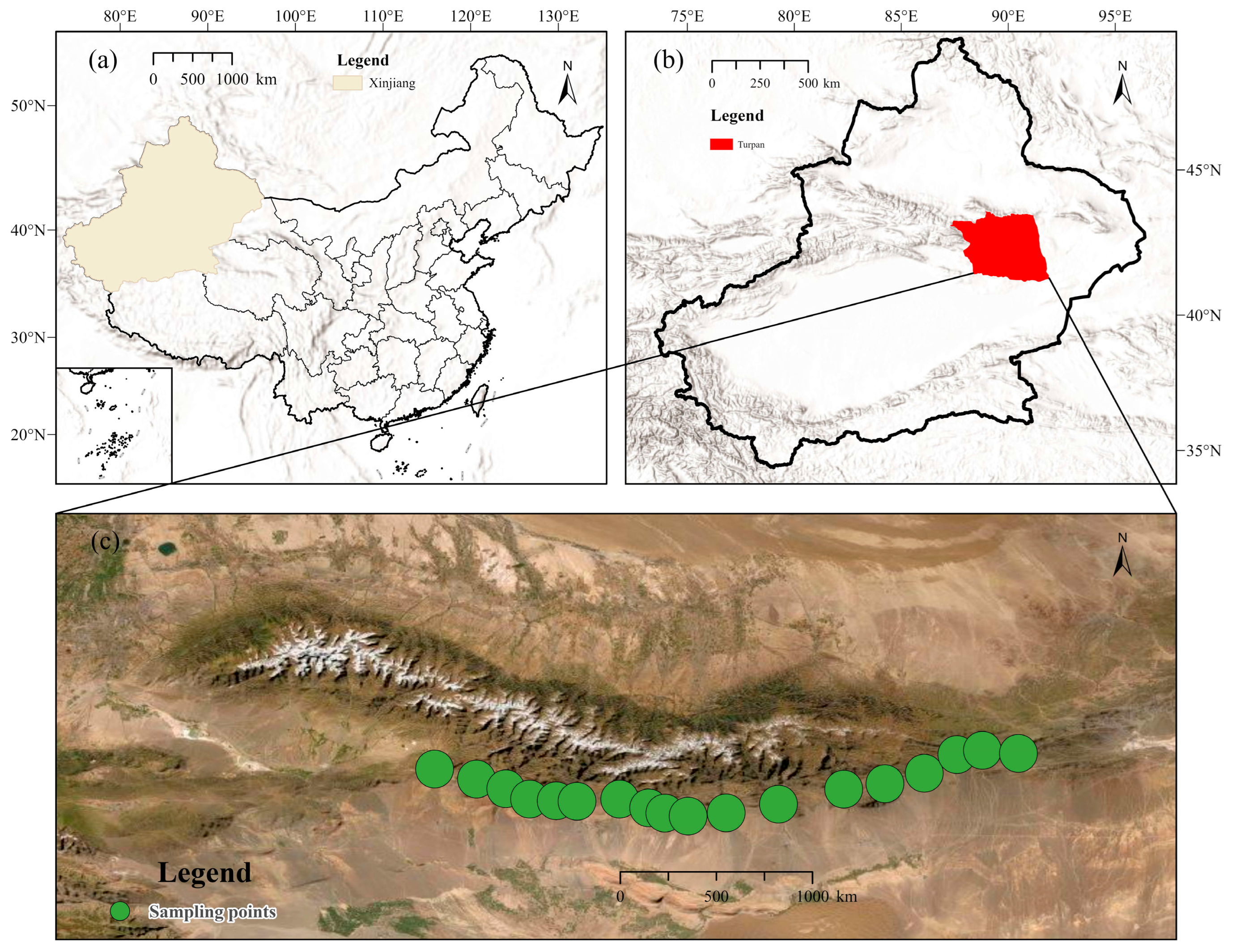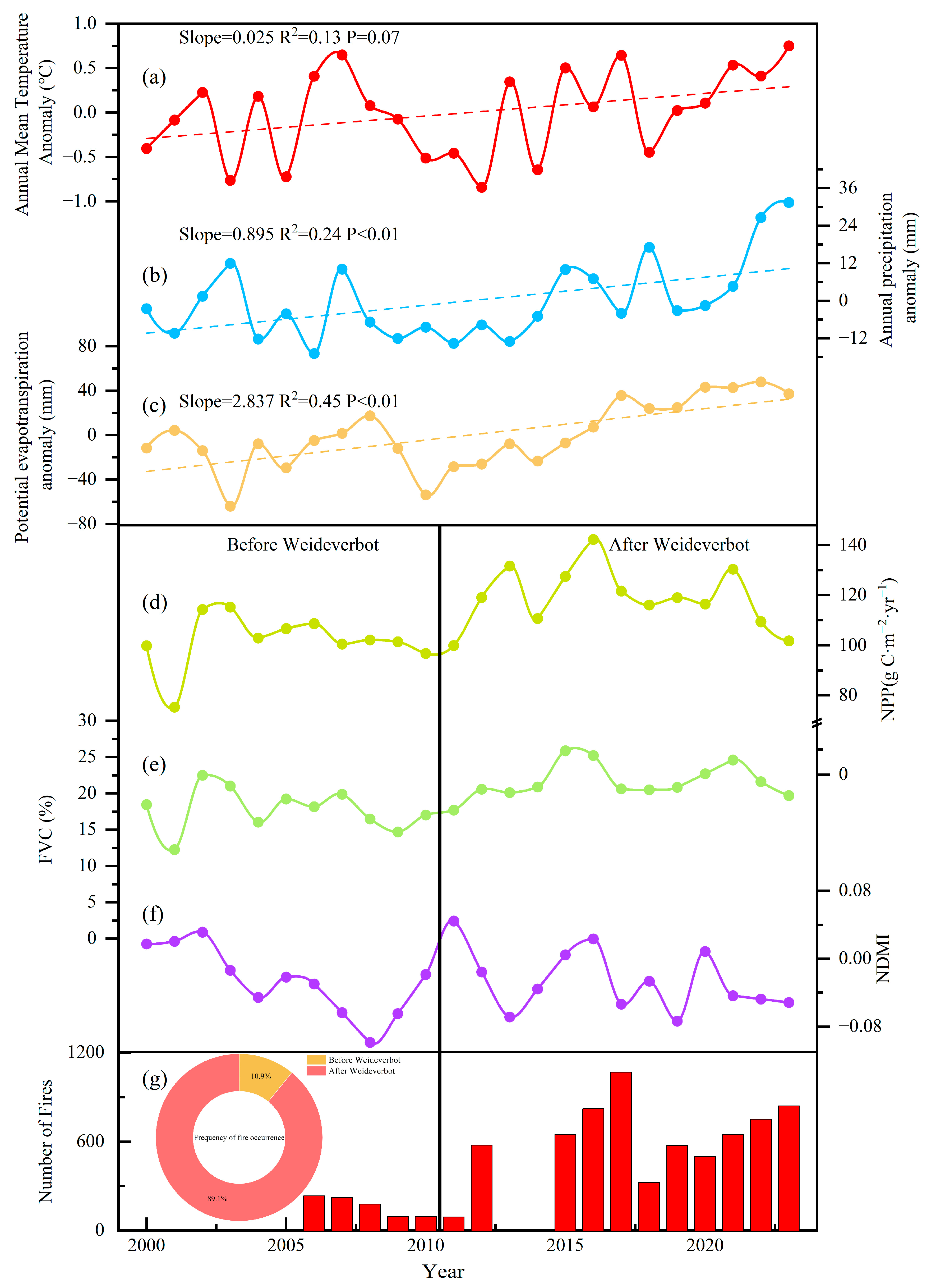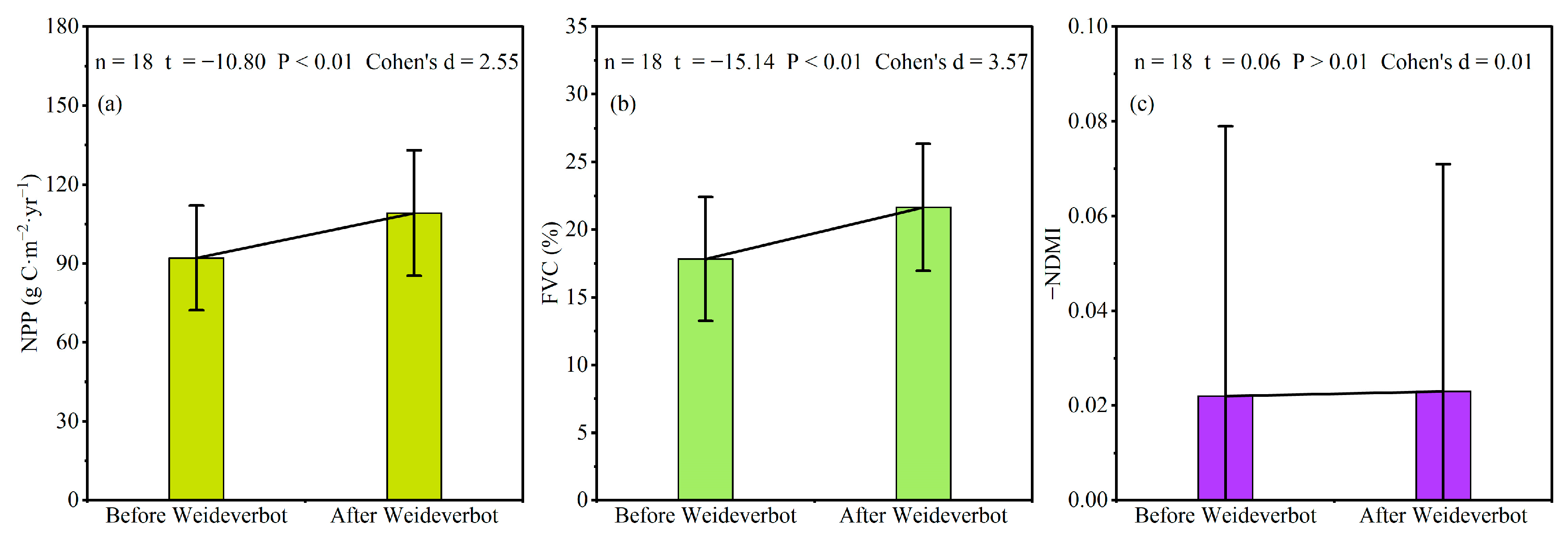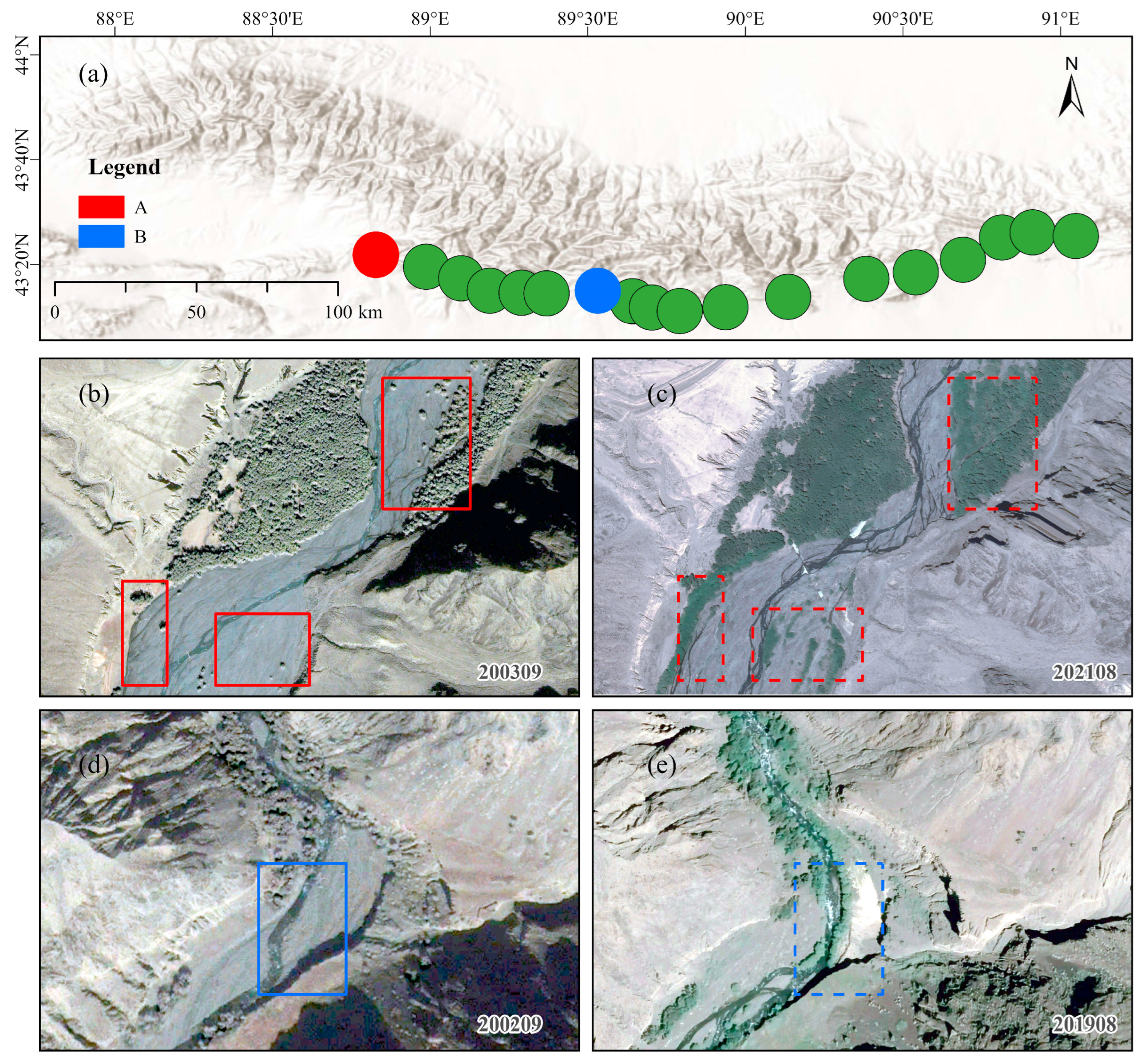Weideverbot Enhances Fire Risk: A Case Study in the Turpan Region, China
Abstract
1. Introduction
2. Materials and Methods
2.1. Study Area
2.2. Data
2.3. Statistical Analysis
3. Results
3.1. Climatic Trends
3.2. Vegetation Changes Post-Prohibition
3.3. Fire Frequency
4. Discussion
4.1. Drivers of Increased Fire Risk: Disentangling Weideverbot, Climate, and Human Activities
4.2. Local Mechanisms: NDMI Stability and the Role of Dead Fuel Accumulation
4.3. Limitations of This Study
5. Conclusions
Author Contributions
Funding
Data Availability Statement
Conflicts of Interest
References
- Bai, Y.; Cotrufo, M.F. Grassland Soil Carbon Sequestration: Current Understanding, Challenges, and Solutions. Science 2022, 377, 603–608. [Google Scholar] [CrossRef]
- Assesment, M.E. Ecosystems and Human Well-Being: Synthesis. Phys. Teach. 2005, 34, 534. [Google Scholar] [CrossRef]
- Bardgett, R.D.; Bullock, J.M.; Lavorel, S.; Manning, P.; Schaffner, U.; Ostle, N.; Chomel, M.; Durigan, G.; Fry, E.L.; Johnson, D.; et al. Combatting Global Grassland Degradation. Nat. Rev. Earth Environ. 2021, 2, 720–735. [Google Scholar] [CrossRef]
- Deng, L.; Shangguan, Z.-P.; Wu, G.-L.; Chang, X.-F. Effects of Grazing Exclusion on Carbon Sequestration in China’s Grassland. Earth-Sci. Rev. 2017, 173, 84–95. [Google Scholar] [CrossRef]
- Peng, C.; Shi, L.; He, Y.; Yao, Z.; Lin, Z.; Hu, M.; Yin, N.; Xu, H.; Li, Y.; Zhou, H.; et al. Climate Factors Regulate the Depth Dependency of Soil Organic Carbon under Grazing Exclusion in Chinese Grasslands: A Meta-Analysis. Land Degrad. Dev. 2023, 34, 4924–4934. [Google Scholar] [CrossRef]
- Sun, J.; Liang, E.; Barrio, I.C.; Chen, J.; Wang, J.; Fu, B. Fences Undermine Biodiversity Targets. Science 2021, 374, 269. [Google Scholar] [CrossRef] [PubMed]
- Jolly, W.M.; Cochrane, M.A.; Freeborn, P.H.; Holden, Z.A.; Brown, T.J.; Williamson, G.J.; Bowman, D.M.J.S. Climate-Induced Variations in Global Wildfire Danger from 1979 to 2013. Nat. Commun. 2015, 6, 7537. [Google Scholar] [CrossRef]
- Parmenter, R.R. Long-Term Effects of a Summer Fire on Desert Grassland Plant Demographics in New Mexico. Rangel. Ecol. Manag. 2008, 61, 156–168. [Google Scholar] [CrossRef]
- Liu, X.; Zhang, J.; Cai, W.; Tong, Z. Information Diffusion-Based Spatio-Temporal Risk Analysis of Grassland Fire Disaster in Northern China. Know.-Based Syst. 2010, 23, 53–60. [Google Scholar] [CrossRef]
- Radeloff, V.C.; Mockrin, M.H.; Helmers, D.; Carlson, A.; Hawbaker, T.J.; Martinuzzi, S.; Schug, F.; Alexandre, P.M.; Kramer, H.A.; Pidgeon, A.M. Rising Wildfire Risk to Houses in the United States, Especially in Grasslands and Shrublands. Science 2023, 382, 702–707. [Google Scholar] [CrossRef]
- Niu, S.; Liang, Y.; Zhang, S. Countermeasures of forest fire prevention and control in Tianchi Nature Reserve of Xinjiang after grazing prohibition. For. Fire Prev. 2015, 1, 30–32. [Google Scholar]
- Yie, J.; Li, Z.; Xie, S. Research on the Trade-off and Synergy Relationship of Ecosystem Services in Turpan City, China. J. Kashi Univ. 2024, 45, 42–48. [Google Scholar] [CrossRef]
- Hou, F. Remote Sensing and GIS-Based Analysis on Temporal-Spatial Evolution and Forecast of Land Use Change in Turpan City. Master’s Thesis, Xinjiang University, Urumqi, China, 2011. [Google Scholar]
- Brown, P.T.; Hanley, H.; Mahesh, A.; Reed, C.; Strenfel, S.J.; Davis, S.J.; Kochanski, A.K.; Clements, C.B. Climate Warming Increases Extreme Daily Wildfire Growth Risk in California. Nature 2023, 621, 760–766. [Google Scholar] [CrossRef] [PubMed]
- Zhang, R.; Tian, D.; Chen, H.Y.H.; Seabloom, E.W.; Han, G.; Wang, S.; Yu, G.; Li, Z.; Niu, S. Biodiversity Alleviates the Decrease of Grassland Multifunctionality under Grazing Disturbance: A Global Meta-Analysis. Glob. Ecol. Biogeogr. 2022, 31, 155–167. [Google Scholar] [CrossRef]
- Rouet-Leduc, J.; Pe’er, G.; Moreira, F.; Bonn, A.; Helmer, W.; Shahsavan Zadeh, S.A.A.; Zizka, A.; van der Plas, F. Effects of Large Herbivores on Fire Regimes and Wildfire Mitigation. J. Appl. Ecol. 2021, 58, 2690–2702. [Google Scholar] [CrossRef]
- Wollstein, K.; Wardropper, C.B.; Becker, D.R. Outcome-Based Approaches for Managing Wildfire Risk: Institutional Interactions and Implementation Within the “Gray Zone”. Rangel. Ecol. Manag. 2021, 77, 101–111. [Google Scholar] [CrossRef]
- van der Werf, G.R.; Randerson, J.T.; Giglio, L.; Collatz, G.J.; Mu, M.; Kasibhatla, P.S.; Morton, D.C.; DeFries, R.S.; Jin, Y.; van Leeuwen, T.T. Global Fire Emissions and the Contribution of Deforestation, Savanna, Forest, Agricultural, and Peat Fires (1997–2009). Atmos. Chem. Phys. 2010, 10, 11707–11735. [Google Scholar] [CrossRef]
- Ryan, C.M.; Williams, M. How Does Fire Intensity and Frequency Affect Miombo Woodland Tree Populations and Biomass? Ecol. Appl. 2011, 21, 48–60. [Google Scholar] [CrossRef]
- Van Wilgen, B.W.; Govender, N.; Biggs, H.C.; Ntsala, D.; Funda, X.N. Response of Savanna Fire Regimes to Changing Fire-Management Policies in a Large African National Park. Conserv. Biol. 2004, 18, 1533–1540. [Google Scholar] [CrossRef]
- Busby, G.M.; Albers, H.J.; Montgomery, C.A. Wildfire Risk Management in a Landscape with Fragmented Ownership and Spatial Interactions. Land Econ. 2012, 88, 496–517. [Google Scholar] [CrossRef]
- Fuhlendorf, S.D.; Engle, D.M. Restoring Heterogeneity on Rangelands: Ecosystem Management Based on Evolutionary Grazing Patterns: We Propose a Paradigm That Enhances Heterogeneity Instead of Homogeneity to Promote Biological Diversity and Wildlife Habitat on Rangelands Grazed by Livestock. BioScience 2001, 51, 625–632. [Google Scholar]
- Potts, D.L.; Suding, K.N.; Winston, G.C.; Rocha, A.V.; Goulden, M.L. Ecological Effects of Experimental Drought and Prescribed Fire in a Southern California Coastal Grassland. J. Arid Environ. 2012, 81, 59–66. [Google Scholar] [CrossRef]
- Assal, T.J.; Anderson, P.J.; Sibold, J. Spatial and temporal trends of drought effects in a heterogeneous semi-arid forest ecosystem. For. Ecol. Manag. 2016, 365, 137–151. [Google Scholar] [CrossRef]




| Mean ± SD | Cohen’s d | p | t | n | ||
|---|---|---|---|---|---|---|
| Before Weideverbot | After Weideverbot | |||||
| NPP (g C·m−2·yr−1) | 92.06 ±19.88 | 109.17 ± 23.91 | 2.55 | <0.01 | −10.80 | 18 |
| FVC (%) | 17.85 ± 4.58 | 21.65 ± 4.69 | 3.57 | <0.01 | −15.14 | 18 |
| −NDMI | 0.022 ± 0.05 | 0.023 ± 0.04 | 0.01 | >0.01 | 0.06 | 18 |
Disclaimer/Publisher’s Note: The statements, opinions and data contained in all publications are solely those of the individual author(s) and contributor(s) and not of MDPI and/or the editor(s). MDPI and/or the editor(s) disclaim responsibility for any injury to people or property resulting from any ideas, methods, instructions or products referred to in the content. |
© 2025 by the authors. Licensee MDPI, Basel, Switzerland. This article is an open access article distributed under the terms and conditions of the Creative Commons Attribution (CC BY) license (https://creativecommons.org/licenses/by/4.0/).
Share and Cite
An, C.; Zheng, L. Weideverbot Enhances Fire Risk: A Case Study in the Turpan Region, China. Land 2025, 14, 2131. https://doi.org/10.3390/land14112131
An C, Zheng L. Weideverbot Enhances Fire Risk: A Case Study in the Turpan Region, China. Land. 2025; 14(11):2131. https://doi.org/10.3390/land14112131
Chicago/Turabian StyleAn, Chengbang, and Liyuan Zheng. 2025. "Weideverbot Enhances Fire Risk: A Case Study in the Turpan Region, China" Land 14, no. 11: 2131. https://doi.org/10.3390/land14112131
APA StyleAn, C., & Zheng, L. (2025). Weideverbot Enhances Fire Risk: A Case Study in the Turpan Region, China. Land, 14(11), 2131. https://doi.org/10.3390/land14112131





